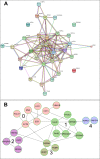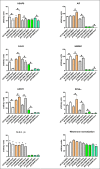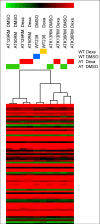Proteomics and transcriptomics analyses of ataxia telangiectasia cells treated with Dexamethasone
- PMID: 29608596
- PMCID: PMC5880408
- DOI: 10.1371/journal.pone.0195388
Proteomics and transcriptomics analyses of ataxia telangiectasia cells treated with Dexamethasone
Abstract
Ataxia telangiectasia (A-T) is an incurable and rare hereditary syndrome. In recent times, treatment with glucocorticoid analogues has been shown to improve the neurological symptoms that characterize this condition, but the molecular mechanism of action of these analogues remains unknown. Hence, the aim of this study was to gain insight into the molecular mechanism of action of glucocorticoid analogues in the treatment of A-T by investigating the role of Dexamethasone (Dexa) in A-T lymphoblastoid cell lines. We used 2DE and tandem MS to identify proteins that were influenced by the drug in A-T cells but not in healthy cells. Thirty-four proteins were defined out of a total of 746±63. Transcriptome analysis was performed by microarray and showed the differential expression of 599 A-T and 362 wild type (WT) genes and a healthy un-matching between protein abundance and the corresponding gene expression variation. The proteomic and transcriptomic profiles allowed the network pathway analysis to pinpoint the biological and molecular functions affected by Dexamethasone in Dexa-treated cells. The present integrated study provides evidence of the molecular mechanism of action of Dexamethasone in an A-T cellular model but also the broader effects of the drug in other tested cell lines.
Conflict of interest statement
Figures







Similar articles
-
ATM splicing variants as biomarkers for low dose dexamethasone treatment of A-T.Orphanet J Rare Dis. 2017 Jul 5;12(1):126. doi: 10.1186/s13023-017-0669-2. Orphanet J Rare Dis. 2017. PMID: 28679388 Free PMC article.
-
Nano-Mechanical Characterization of Ataxia Telangiectasia Cells Treated with Dexamethasone.Cell Biochem Biophys. 2017 Mar;75(1):95-102. doi: 10.1007/s12013-016-0775-0. Epub 2016 Dec 8. Cell Biochem Biophys. 2017. PMID: 27933465
-
Forward subtractive libraries containing genes transactivated by dexamethasone in ataxia-telangiectasia lymphoblastoid cells.Mol Cell Biochem. 2014 Jul;392(1-2):13-30. doi: 10.1007/s11010-014-2013-7. Epub 2014 Mar 14. Mol Cell Biochem. 2014. PMID: 24627244
-
Dexamethasone partially rescues ataxia telangiectasia-mutated (ATM) deficiency in ataxia telangiectasia by promoting a shortened protein variant retaining kinase activity.J Biol Chem. 2012 Nov 30;287(49):41352-63. doi: 10.1074/jbc.M112.344473. Epub 2012 Oct 10. J Biol Chem. 2012. PMID: 23055520 Free PMC article.
-
Betamethasone therapy in ataxia telangiectasia: unraveling the rationale of this serendipitous observation on the basis of the pathogenesis.Eur J Neurol. 2013 May;20(5):740-7. doi: 10.1111/ene.12024. Epub 2012 Nov 4. Eur J Neurol. 2013. PMID: 23121321 Review.
Cited by
-
Inflammation and transcriptional responses of peripheral blood mononuclear cells in classic ataxia telangiectasia.PLoS One. 2018 Dec 26;13(12):e0209496. doi: 10.1371/journal.pone.0209496. eCollection 2018. PLoS One. 2018. PMID: 30586396 Free PMC article.
-
Novel 3D-printed hollow microneedles facilitate safe, reliable, and informative sampling of perilymph from guinea pigs.Hear Res. 2021 Feb;400:108141. doi: 10.1016/j.heares.2020.108141. Epub 2020 Dec 2. Hear Res. 2021. PMID: 33307286 Free PMC article.
-
The positive short-term effect of dexamethasone on ataxia symptoms in a patient with ataxia-telangiectasia: A case report.Clin Case Rep. 2022 May 20;10(5):e05895. doi: 10.1002/ccr3.5895. eCollection 2022 May. Clin Case Rep. 2022. PMID: 35600021 Free PMC article.
-
iTRAQ-Based Analysis of Proteins Co-Regulated by Brassinosteroids and Gibberellins in Rice Embryos during Seed Germination.Int J Mol Sci. 2018 Nov 4;19(11):3460. doi: 10.3390/ijms19113460. Int J Mol Sci. 2018. PMID: 30400353 Free PMC article.
-
The Chromosome Passenger Complex (CPC) Components and Its Associated Pathways Are Promising Candidates to Differentiate Between Normosensitive and Radiosensitive ATM-Mutated Cells.Biomark Insights. 2024 Oct 30;19:11772719241274017. doi: 10.1177/11772719241274017. eCollection 2024. Biomark Insights. 2024. PMID: 39493730 Free PMC article.
References
-
- Savitsky K, Sfez S, Tagle DA, Ziv Y, Sartiel A, Collins FS, et al. (1995) The complete sequence of the coding region of the ATM gene reveals similarity to cell cycle regulators in different species. HumMolGenet 4: 2025–2032. - PubMed
-
- Abraham RT (2004) PI 3-kinase related kinases: 'big' players in stress-induced signaling pathways. DNA Repair (Amst) 3: 883–887. - PubMed
-
- Shiloh Y, Ziv Y (2013) The ATM protein kinase: regulating the cellular response to genotoxic stress, and more. NatRevMolCell Biol 14: 197–210. - PubMed
-
- Chaudhary MW, Al-Baradie RS (2014) Ataxia-telangiectasia: future prospects. Appl Clin Genet 7: 159–167. doi: 10.2147/TACG.S35759 - DOI - PMC - PubMed
Publication types
MeSH terms
Substances
LinkOut - more resources
Full Text Sources
Other Literature Sources
Medical

